 Magnesium strip burning by Cpt. John Yossarian via Wikimedia Commons. Licensed by CC.
Magnesium strip burning by Cpt. John Yossarian via Wikimedia Commons. Licensed by CC.
We encounter thousands of chemical reactions every day: plants use them in photosynthesis, metals rust over time, and combustion reactions provide us with heat and light, among thousands of other daily uses. Chemical reactions occur when reactants transform into new substances, called products, through creating and breaking bonds between atoms. Sometimes the process creates some pretty wild effects. Check out our top 10 chemical reactions below:
1) Disintegration (Mercury Reacts with Aluminum)

Image credit: Theodore Gray via Youtube
When aluminum rusts, it creates a protective oxide layer that prevents the aluminum atoms underneath from further rusting. That is, until mercury is applied. Mercury prevents an oxide layer from forming, making the rust reaction continue uncontrollably. The process isn't as fast as what's depicted in the GIF though; it actually took two hours to rust through the aluminum beam above. What isn't depicted in the GIF is the sluffed off rust that formed a pile at the base of the aluminum beam as the reaction progressed.
2) Pharaoh's Serpent (Mercury (II) Thiocyanate Reacts with Oxygen)

Image credit: tenkowal via Youtube
The reaction depicted above, nicknamed the "Pharoah's Serpent," actually use to be a common classroom demonstration. It also use to be sold in stores as fireworks until people realized it's actually fairly toxic. As its name hints, it contains very poisonous mercury. Mercury (II) thiocyanate exists as a white solid that when heated, expands to become a brown solid due to its decomposition to carbon nitride. Sulfur dioxide and mercury (II) sulfide are also produced. Nowadays, if you want a similar effect but don't want to risk touching mercury, you can try making a "Black Snake" by heating a mixture of sugar and baking soda in a beaker.
3) Explosive Gummi Bear (Heated Potassium Chlorate Reacts with a Gummi Bear)
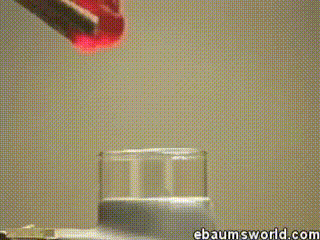
Image credit: ebaum via ebaumsworld.com
Potassium chlorate is considered a strong oxidizing agent. When it's gently heated, a decomposition reaction occurs, which produces potassium chloride and a lot of oxygen. This excess oxygen is enough to ignite something like a Gummi bear if it's dropped into the solution, which produces light, heat, carbon dioxide and water. The heat from the Gummi bear reaction further fuels the original decomposition of the potassium chlorate. The result is the extremely rapid combustion reaction you see in the GIF.
4) Copper Displacement (Iron Reacts with Copper Sulfate)
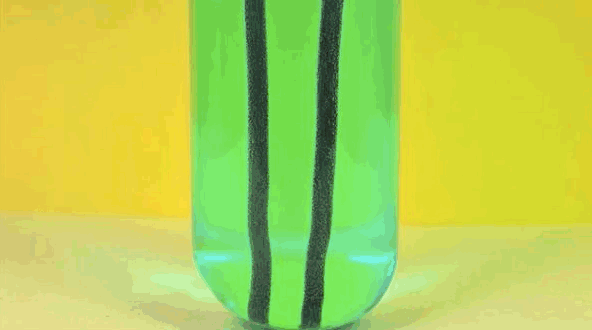
Image credit: DizzyCtube via Youtube
When iron is added to copper sulphate, a single displacement reaction occurs. In the GIF above, iron rods are placed in a test tube containing a bluish copper sulphate solution. Since iron is more reactive than copper, it displaces the copper to form iron sulphate. The result? Copper deposits form on the iron rods and the solution changes color as it becomes iron sulphate. If you remove the copper from the solution and reweighed the rods, you'd see that it lost a mass equivalent to the amount of iron that reacted to form iron sulphate.
5) Fire Bottle (Isopropyl Alcohol Reacts with Oxygen)
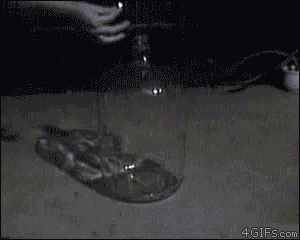
Image credit: raja3894 via Youtube
This combustion reaction in the GIF above, sometimes called a "Fire Bottle," is actually just 70% alcohol reacting with heat. Very little alcohol is poured into the bottle, which is then shaken to mix it with air. This turns it into a vapour and it can then be lit from the top of the jar, producing the combustion reaction you see. The reaction travels down the container, making a 'whoosh' sound as it uses up the oxygen inside the bottle and eventually puts itself out.
6) Instant Snow (Sodium Polyacrylate Reacts with Water)
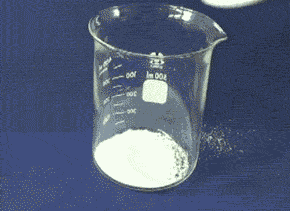
Image credit: profbunsen2 via Youtube
Sodium polyacrylate is a superabsorbant polymer that normally looks like a white powder. In this form, sodium atoms in the long, densely coiled polymer chains are linked to oxygen atoms. In this state, there is no net charge. When water is added, the links are broken and the sodium ions are suddenly free to repel one another. This unravels the polymer chains, making them become a polymer mesh that traps water. The resulting product appears very similar to fake snow and is cool to the touch.
7) Explosive Polymerization (4-Nitroanaline Reacts with Sulfuric Acid and Heat)

Image credit: Adrian McLaughlin via Youtube
That's not coffee you see in the cup. In the 1970s, NASA studied the reaction in the GIF above because they saw its potential to be used to control fire outbreaks on spaceships. An explosive polymerization reaction occurs when 4-nitroanaline reacts with sulfuric acid and heat. Sulfur dioxide and water are produced as a result, expanding to form the foam you see. The foam is low-density and fire-retardent.
8) Elephant's Toothpaste (Hydrogen Peroxide Catalyzed by Potassium Iodide)
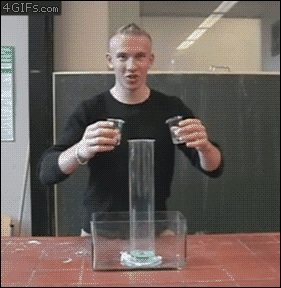
Image credit: 4gifs via Tumblr
Also called the "Marshmallow Experiment," the iodine ion from potassium iodide catalyzes the decomposition of hydrogen peroxide. When this occurs, oxygen gas rapidly forms. In the GIF you see here, soap and food colouring are also added, which traps the oxygen as it attempts to escape. The result is a foam snake that looks like an elephant's trunk or toothpaste.
9) Dry Ice Light (Magnesium Reacts with Dry Ice)

Image credit: University of Minnesota
Magnesium normally reacts with oxygen to form magnesium oxide, but it's actually so reactive that it's able to burn with carbon dioxide as well. If you stick magnesium in dry ice -- which is just solid carbon dioxide (CO2) -- it forces the magnesium to react only with the oxygen contained in carbon dioxide. The result is a much more powerful single displacement reaction, which produces magnesium oxide, carbon, and a lot of heat and light.
10) Rocket Combustion (Fuming Nitric Acid Reacts with Nitrile Gloves)

Image credit: Nile Red via Youtube
Fuming nitric acid is what you get when the concentration of nitric acid is greater than 70%. Red fuming nitric acid is an extremely strong oxidizer and reacts readily in contact with organic compounds like acetone. In addition, its vapor is corrosive and causes severe burns. As a main component in certain types of rocket fuel, it has a tendency of producing very exothermic reactions. When it comes in contact with nitrile gloves, for instance, it sets them on fire, as you can see in the GIF.
September 15, 2014 | by Laura Suen
No comments:
Post a Comment